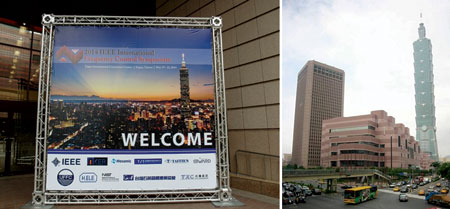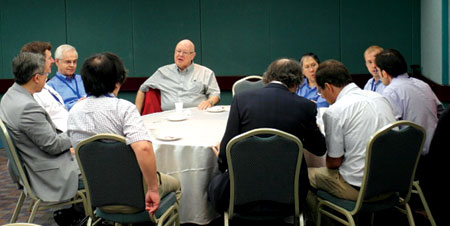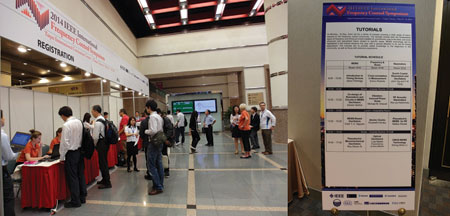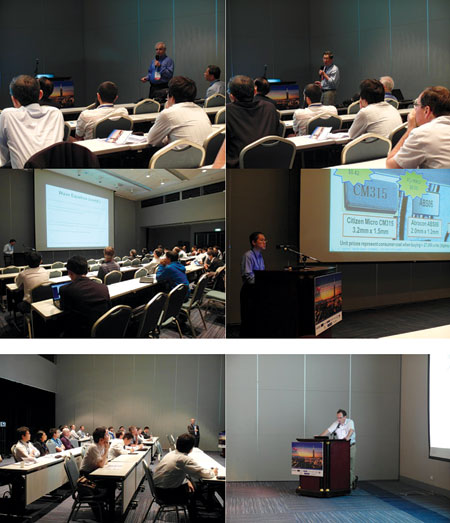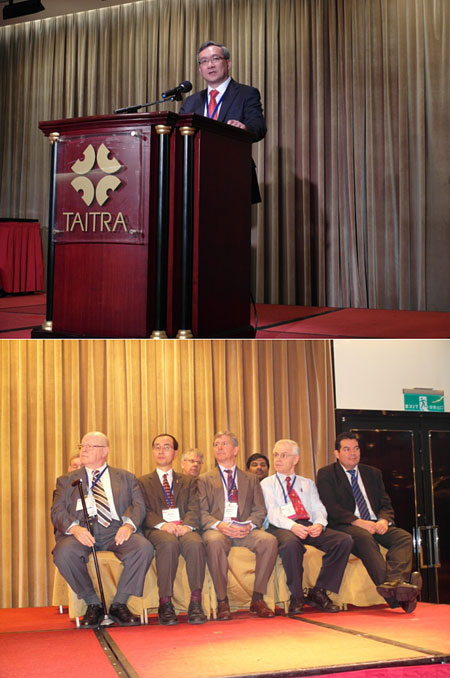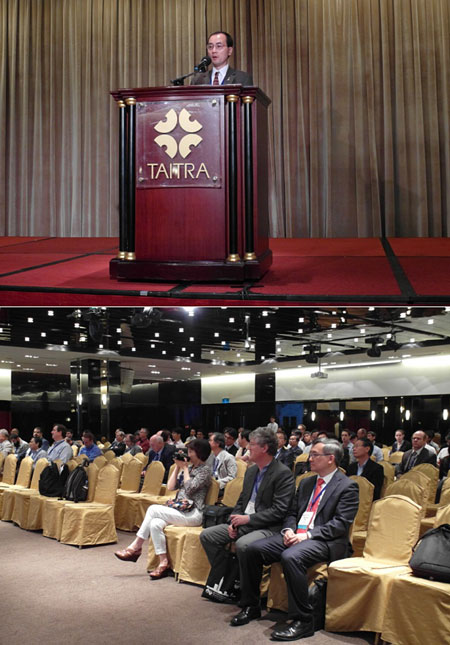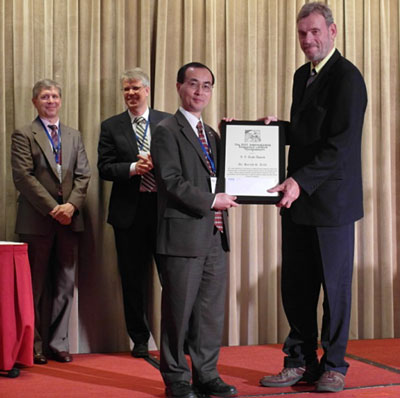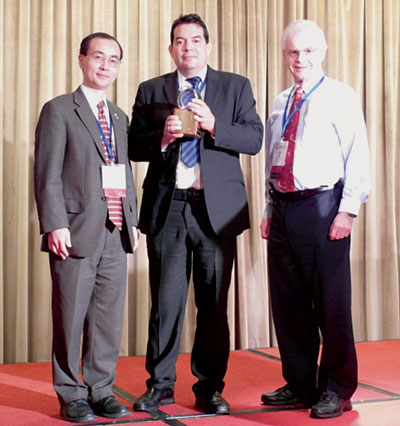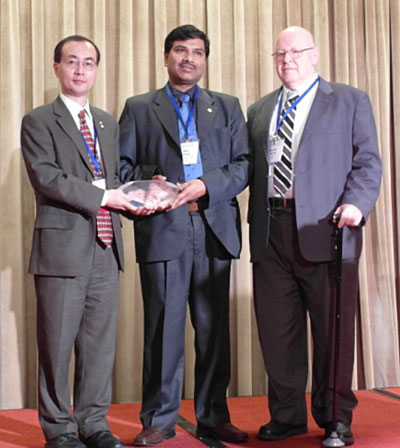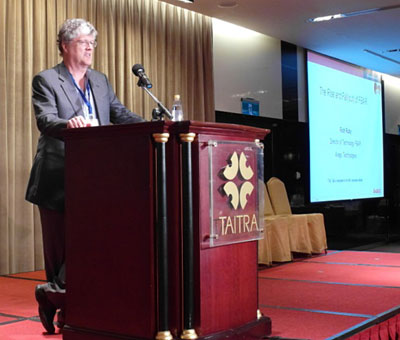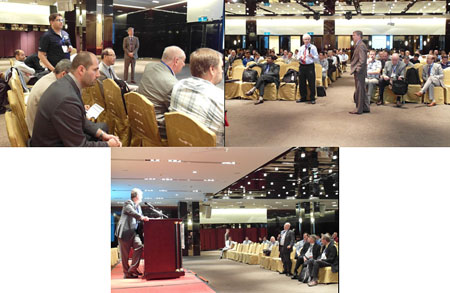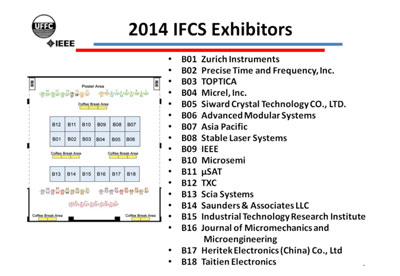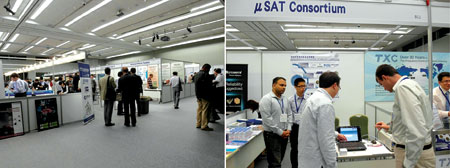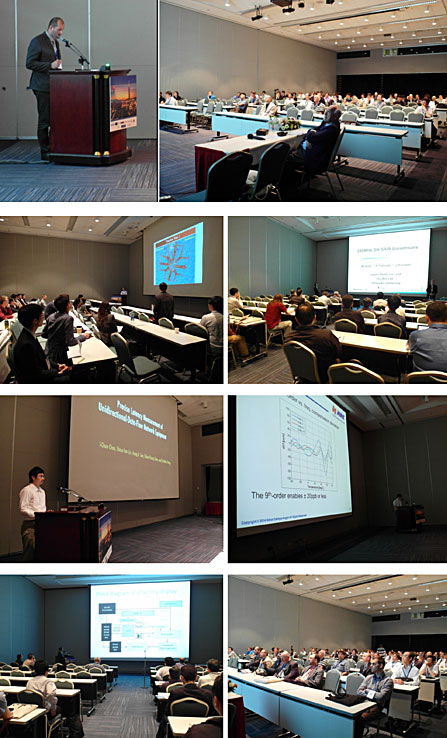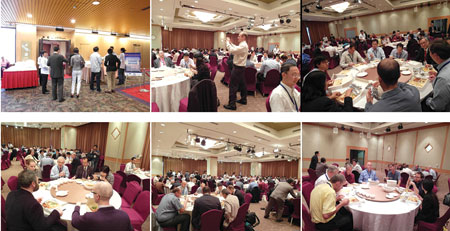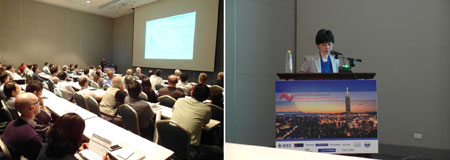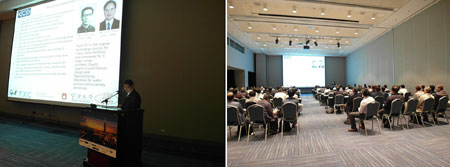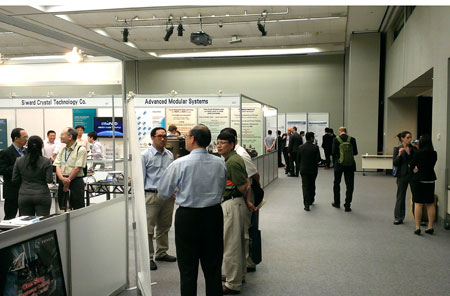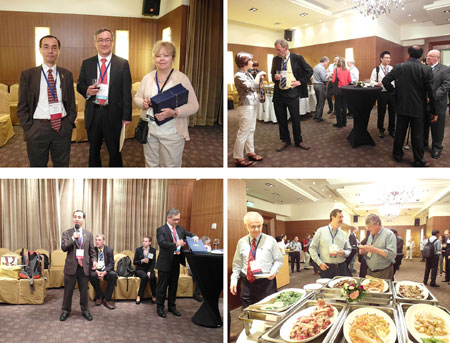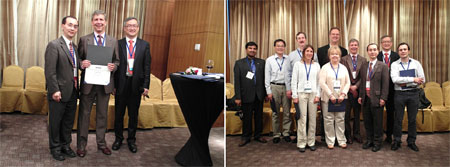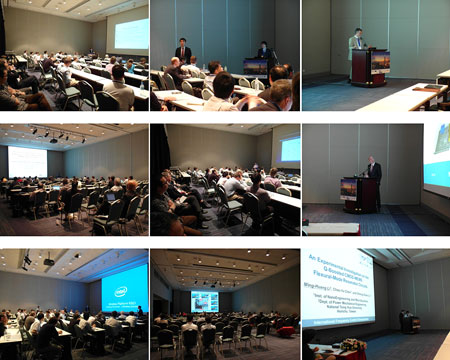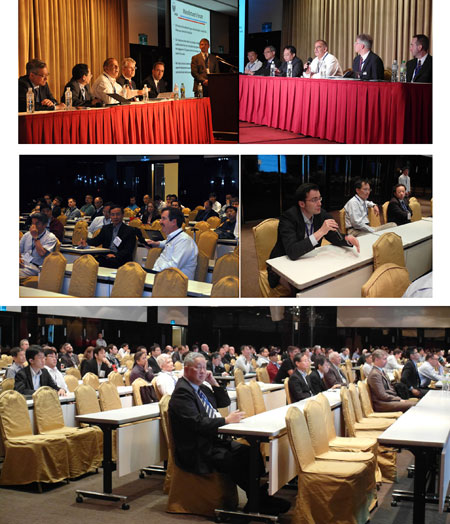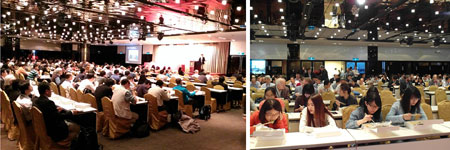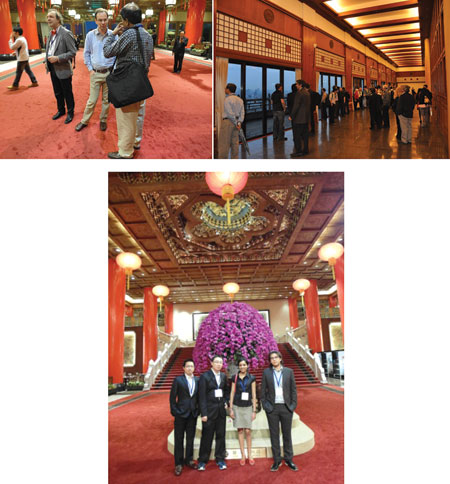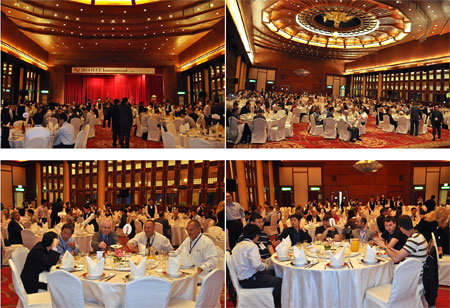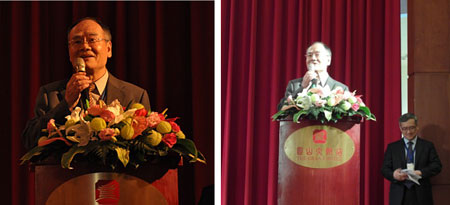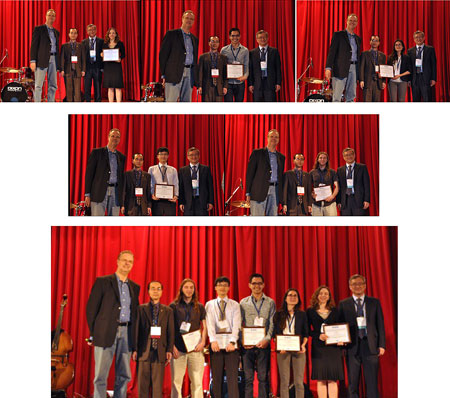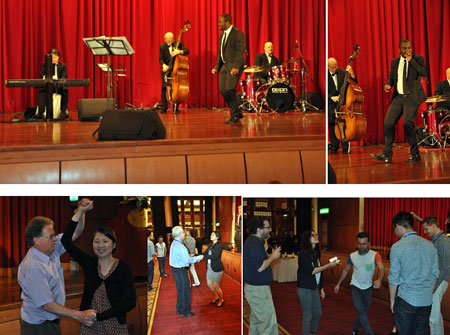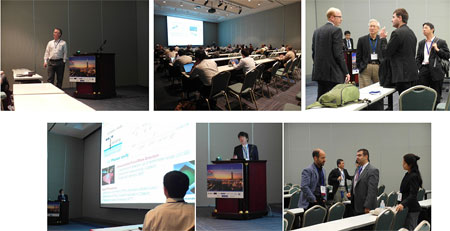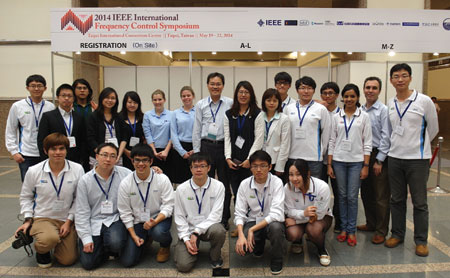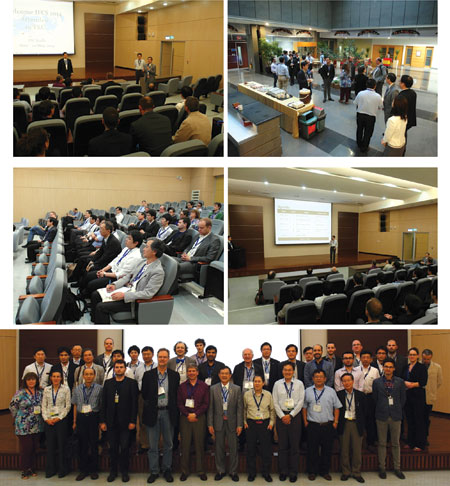| IEEE.org | IEEE Xplore Digital Library | IEEE Standards | IEEE Spectrum | More Sites |
|
|
|
To ensure you receive our e-mail, please add e-mail@ieee.org to your address book now.
|
|
In this issue
Transactions on UFFC
The October Issue of Transactions on UFFC is in the mail and is retrievable now from IEEE Xplore, the IEEE online digital library.
All UFFC members can access the online edition using their IEEE Account. 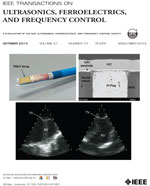
Most downloaded articles:
For Newsletter comments, suggestions, critique, etc. contact Mike Garvey rmgarvey@ieee.org
|
2014 International Frequency Control Symposium by Sheng-Shian Li, Associate Newsletter Editor for IFCS
Since the Symposium, as usual, was organized with the help of Conference Catalysts, there was a need to find a strong local team as a point of contact to the US team. Therefore, I applied for a project from the National Science Council of Taiwan with sufficient funding to hire a local team, the Instrument Technology Research Center (ITRC), to support all logistics. The Symposium started on May 19th; the Symposium venue and the IFCS’14 banner are shown in Fig. 1. With total 228 abstracts submitted in this year, there were finally 101 oral papers (including 20 invited talks) and 76 poster papers presented in the Symposium.
in Fig. 2 right before the tutorial sessions begun. Fig. 3 shows the tutorial registration status in front of the registration booths and the program. There were more than 50 attendees registered in the tutorial sessions, showing a comparable number to the past. Fig. 4 presents the photos taken in various tutorial lectures. We received a great deal of positive feedback from the participants regarding the tutorial program.
The formal Symposium on May 20th was initiated by an opening session organized by the General Chair, Dr. Wan-Thai Hsu. In the opening session shown in Fig. 5, Wan-Thai delivered a short speech to welcome everyone while the 2014 IFCS award recipients and individuals giving laudation were all seated on the stage. The UFFC President, Dr. Jian-yu Lu, also gave a warm welcome message to all the attendees and showed appreciation to the organizers of the Symposium as shown in Fig. 6.
Then IEEE IFCS Awards session was organized by the symposium technical program committee chair, Dr. Gregory Weaver. The awards were: The 2014 I.I. Rabi Award awarded to Dr. Harald Telle for “For most significant contributions to high precision frequency control andmeasurements, in particular to optical frequency chains, the invention of the phase-coherent optical frequency interval division technique and early groundwork and demonstration of optical frequency combs and their use for frequency synthesis.”
as shown in Fig. 7. The laudation was The 2014 W.G. Cady Award was awarded to Dr. Michael Tobar for “For the development of high-Q resonators and low-noise devices as shown in Fig. 8. The laudation was The 2014 C.B. Sawyer Award went to
However, Dr. Rohde was unable to attend and his representative received the award for him; the laudation was given by Vice-President IEEE IFCS, Michael M. Driscoll.
Followed by the Awards session, the Plenary Talk entitled “The Rise and Fall(Out) of FBAR” was given by Dr. Rich Ruby from Avago Tech, as shown in Fig. 10. This talk was started by covering the early days of FBAR leading up to the introduction of the duplexer in 2001 and the following duplexer families using an all-silicon, wafer-scale, chip scale package in 2003. The second half of his talk explored a vision of how the unique properties of AlN combined with the ability to integrate circuitry to overcome imperfections in an FBAR resonator and to create a better ‘resonator’ that potentially could be disruptive. This was an excellent talk which attracted many local companies to attend due to the importance of the FBAR technology and related products used in 4G LTE. The Q&A time right after the plenary talk was hosted by Dr. Gregory Weaver and the active discussion and debating, shown in Fig. 11, successfully ended this session.
After the plenary talk, there was a break in the 2nd floor
After the short break, the regular sessions started in the first floor of the TICC. There were three sessions in parallel and the attendees found their interests in each room as shown in Fig. 15. Fortunately, the layout of the three parallel sessions was formed by a square separated into three lecture rooms (101A, 101B, and 101CD) at the same floor, which allowed the attendees to efficiently switch topics if the talks of interest were in different rooms. Right after the morning oral sessions, the attendees went up to the 4th floor for the lunch in the VIP room. As shown in Fig. 16, the attendees picked up their lunch boxes with traditional Taiwanese food and sat in round tables, facilitating the networking and communication.
The afternoon oral sessions started after lunch; the sessions are shown in Fig. 17. In order to have rough understanding on the local development history of quartz, we invited TXC Corp. to deliver an interesting talk on the perspectives of the quartz crystal devices industry and technologies in Taiwan and China. This talk attracted many people as shown in Fig. 18; this also provided a good opportunity to mix the international and domestic companies in quartz industry. There were two poster sessions arranged in this symposium. The first poster session was in the afternoon of May 20th as shown in Fig. 19. The student paper competition was also held at the same time. Fig. 20 presents the student paper competition finalists of group 1 and group 2 were presenting their research results to the judges. I also served as judge in group 1 and knew how hard it is to rank their performance since all of the finalists have done a great job in this competition. We took almost one hour to select the winner in group 1. During the poster session, it was also a good timing to look at the exhibitors and to chat with people as shown in Fig. 21.
Right before the Welcoming Reception in the evening, there was a UFFC President's Reception hosted by the President, Dr. Jian-yu Lu, and the IFCS’14 general chair, Dr. Wan-Thai Hsu, as shown in Fig. 22. As can be seen, we enjoyed great food and drink, and relaxed and chatted with our Frequency Control Society friends worldwide. President Lu took the opportunity to convey the UFFC Society's appreciation to the Organizing Committee, the Program Committee, the Local Organization Committee, and all the tutorial lecturers, as shown in Fig. 23. The General Reception for all attendees took place in the exhibition areas on the 2nd floor of the TICC.
On the second day (May 21st) of the symposium, regular sessions in parallel, similar to the first day, started, as shown in Fig. 24. A special program, proposed for the first time in IFCS’14, was the Manufacturers’ Forum. The promotion of the manufacturing and process control on the timing and frequency control devices fits well with the strength and merit in Asia; this is why the idea was implemented. The Forum was designed and arranged by the TPC chair, Dr. Gregory Weaver and there were 6 companies invited to make presentations, as shown in Fig. 25. Included were the quartz, MEMS, atomic clock, and optical companies in the frequency control domain. The forum still stirred several interesting points on manufacturing and process control. Followed by the forum, the lunch was combined with the WIE (IEEE Women in Engineering) lecture as shown in Fig. 26; this event provided an opportunity to women graduate students to become involved in the IEEE Society. In the WIE lecture, we invited Dr. H. D. Lee from Pervasive Displays to talk about “What is Entrepreneurship? Use TFT-LCD Industry as an Example”. Around 30 local IEEE women graduate students signed up in this event.
The spotlight of this Symposium for sure was the May 21st Banquet. The Banquet was in the 12th floor of the Grand Hotel, the most splendid landmark of Taipei, established in 1952 with architectural elements of classic Chinese style, as shown in Fig. 27. The attendees could see the overall view of the Taipei city at this height. There were more than 330 guests attended the Banquet as shown in Fig. 28. The sponsor of the Banquet was the Quartz Industries Association of Taiwan (QIAT); the Chair of QIAT, Dr. S. T. Song, gave an eloquent speech welcoming everyone to Taiwan. The QIAT member companies also actively participated this dinner event to enhance the connection between the Frequency Control Society and the local quartz industry. The Student Paper Competition winners were also announced during the Banquet and the winners in various groups received their awards on the stage as shown in Fig. 30. To enhance the Banquet, we hired a local jazz music band to provide entertainment while having dinner as shown in Fig. 31. With combination of the music and wine, many attendees danced in front of the stage; we were glad most of our attendees enjoyed the nice Banquet in Taiwan.
The last day of the symposium only had 9 oral sessions (Fig. 32). Fig. 33 shows the photo of the Symposium staff to organize this event and take care of all the logistics. They were the staff from the Conference Catalysts, the staff from the Instrument Technology Research Center (ITRC), and the student volunteers from my lab in National Tsing Hua University (NTHU). Without them, we could not make this happen. A special thank you goes to my secretary, Doreen Lin, since she was in charge of almost everything locally to make the process much easier and reliable in our side.
Right after all the oral sessions in the last day, the symposium was perfectly ended by a successful post-Symposium technical tour in the TXC manufacturing site in Peng Cheng. It required almost an hour drive from the Conference venue to TXC. There were about 35 people who joined this tour. As shown in Fig. 34, TXC first provided an introduction describing the company scope and technology. The attendees were then divided into 5 groups for the tour of the quartz manufacturing sites. We thank TXC President, Dr. Paul Lin, for his kind offer to provide the technical visit at the end of the symposium. President Lin was instrumental in having the QIAT provide financial support on the Banquet.
In summary, this was a great event. I appreciate all the help and guidance from the best people I have worked with, especially Wan-Thai. From the very beginning to the end, I enjoyed the experience a great deal and also learned many things which I never had chance to encounter before. It turned out to be an extremely precious experience in my life. I hope everyone also enjoyed IFCS’14 in Taiwan; I look forward to seeing you in Denver next year! The Proceedings of the 2014 IFCS are available in IEEE Xplore, at http://ieeexplore.ieee.org/xpl/mostRecentIssue.jsp?punumber=6850264
|
|
Contact & Support |
Privacy & Opting Out of Cookies |
Terms & Conditions |
Nondiscrimination Policy
A non-profit organization, IEEE is the world's largest professional association for the advancement of technology. © Copyright 2014 IEEE - All rights reserved. Use of this newsletter signifies your agreement to the terms and conditions.
For more information or questions regarding your IEEE membership or IEEE Web Account, please direct your inquiries to the IEEE Contact Center. |

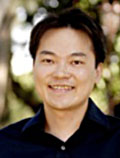 It was my great pleasure to serve as the Chair of the Local Organizing Committee for 2014 International Frequency Control Symposium (IFCS’14) in Taipei International Convention Center (TICC) from May 19th to 22nd. This position also significantly helps me, now as an Associate Newsletter Editor of Frequency Control, to report the details on the IFCS’14 for the UFFC news in this year. I have to admit this is not an easy job since it is the first time the IFCS was held outside of the US in its 67-year history. The General Chair, Dr. Wan-Thai Hsu, and I started to prepare for this event in 2012. Wan-Thai decided to include a formal Conference Banquet to provide some exposure to the history, culture and sites of Taiwan as well as to provide the opportunity for social networking and business communication. We needed extra funding support this idea without affecting the regular registration fee. On the other hand, we also would like to promote the local quartz industry and provide interaction with our international guests. The best way to have the local quartz companies involved in the IFCS’14 is to deliver our Banquet idea with the potential benefits from the IFCS’14 Conference. We contacted the Quartz Industries Association of Taiwan (QIAT) which consists of 21 member companies. Wan-Thai and I attended QIAT’s annual meeting and other events to promote our sponsored Banquet idea. Finally we had QIAT’s commitment to financially support the Conference Banquet in our best historical site in Taipei, the Grand Hotel. QIAT’s member companies were also willing to actively participate the Symposium events, such as the Exhibition, Plenary Talk, Manufacturing Forum, and certainly the Banquet, thus making this Symposium better with more connections and opportunities for localization and technology/business promotion, not just an annual event in Frequency Control. Secondly, one of the major sponsors from QIAT, TXC, was also willing to organize a post-Symposium technical tour for our attendees immediately following the Symposium, thus showing their mature quartz manufacturing processes with two million shipments per month. Finally, in order to leverage the manufacturing excellence in Asia, the “Manufacturing Forum” was proposed for the first time to replace the debating forums in the past.
It was my great pleasure to serve as the Chair of the Local Organizing Committee for 2014 International Frequency Control Symposium (IFCS’14) in Taipei International Convention Center (TICC) from May 19th to 22nd. This position also significantly helps me, now as an Associate Newsletter Editor of Frequency Control, to report the details on the IFCS’14 for the UFFC news in this year. I have to admit this is not an easy job since it is the first time the IFCS was held outside of the US in its 67-year history. The General Chair, Dr. Wan-Thai Hsu, and I started to prepare for this event in 2012. Wan-Thai decided to include a formal Conference Banquet to provide some exposure to the history, culture and sites of Taiwan as well as to provide the opportunity for social networking and business communication. We needed extra funding support this idea without affecting the regular registration fee. On the other hand, we also would like to promote the local quartz industry and provide interaction with our international guests. The best way to have the local quartz companies involved in the IFCS’14 is to deliver our Banquet idea with the potential benefits from the IFCS’14 Conference. We contacted the Quartz Industries Association of Taiwan (QIAT) which consists of 21 member companies. Wan-Thai and I attended QIAT’s annual meeting and other events to promote our sponsored Banquet idea. Finally we had QIAT’s commitment to financially support the Conference Banquet in our best historical site in Taipei, the Grand Hotel. QIAT’s member companies were also willing to actively participate the Symposium events, such as the Exhibition, Plenary Talk, Manufacturing Forum, and certainly the Banquet, thus making this Symposium better with more connections and opportunities for localization and technology/business promotion, not just an annual event in Frequency Control. Secondly, one of the major sponsors from QIAT, TXC, was also willing to organize a post-Symposium technical tour for our attendees immediately following the Symposium, thus showing their mature quartz manufacturing processes with two million shipments per month. Finally, in order to leverage the manufacturing excellence in Asia, the “Manufacturing Forum” was proposed for the first time to replace the debating forums in the past.